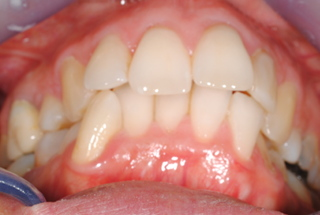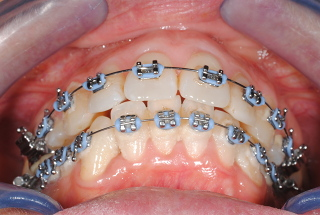What is orthodontics?
Orthodontics is a specialised branch of dentistry responsible for prophylaxis, which involves the diagnosis and treatment of missing teeth. Orthodontics studies and treats crooked and misaligned teeth. This field of dentistry corrects the upper jaw if it is positioned incorrectly, and also corrects abnormal ‘bites’ and teeth that do not meet correctly.
Orthodontics (Braces)

Orthodontics is a specialised branch of dentistry, which is multidisciplinary. In other words, there is a collaboration between this branch and other stomatology fields. In more complex cases, this orthodontic field is combined with periodontal treatments (gum treatments), tooth surgery, endodontics (root canal treatment), aesthetical or functional restorations, and implants. Various health professionals can combine their plans to provide treatment for improved rehabilitation. Orthodontics can be useful for teenagers, adults, persons who might need orthognathic surgery, or patients with cranium anomalies or an abnormal bite.
There are various options for orthodontic treatment. The choice depends on each individual case. The braces can be fixed or removable, partial or complete. They can be made of ceramic or metal and may have modules with several colours or just one colour.
Who can have this orthodontic treatment?
To be able to start an orthodontic treatment, you should not have tooth decay or gum diseases like periodontitis. Adults and children are both candidates for dental correction. Adults are increasingly looking to correct dental aesthetical flaws in their dentition. The correction of these flaws will help to speed up other treatments, such as placement of crowns over the tooth, bridges, and implants. The aesthetical results are better and make oral rehabilitation easier.
Orthodontic Treatment Benefits
Aesthetic – The person will be more confident and will be able to improve personal and professional relationships. A smile gives the first image of a person. Through our smile, we convey feelings of appreciation or aloofness. Some occupations require contact with the public, therefore, it is essential to have a healthy and beautiful smile.
Phonetics and breathing – Deficient breathing can cause sleep disorders and snoring. Orthodontic treatment will enable better breathing and also improve the pronunciation of words. Diction will significantly improve and dental erosion of the surface of the teeth will be prevented.
Chewing – Dental problems cause digestive issues and difficulties while chewing foods. After an orthodontic treatment, patients usually point out how easy it has become to ingest some foods that were previously impossible.
Temporomandibular Joint Syndrome – Malocclusion can cause shoulder, back and neck pain, and headaches. The excessive pressure on the teeth and bone that supports them can affect the mandible joint and cause TMJ. Good dental occlusion prevents these symptoms and contributes to a better quality of life.
Oral hygiene – Misaligned and crowded teeth are hard to clean, therefore, it will increase the probability of gum diseases such as periodontitis, gingivitis, and also tooth decay. In extreme cases, improper hygiene may lead to dental loss. Through the use of orthodontic treatments and dental correction, it will be easier to brush your teeth. The durability of the dental devices will increase and teeth could last a lifetime.
Risks and Adverse Effects of Orthodontic Treatments
Orthodontic treatment is beneficial for the patients, but its advantages and risks should be discussed in order to choose the appropriate treatment.
There is a possibility of decalcification, but the lesion is reversible through remineralisation. This means that the tooth enamel can be damaged. For this reason, oral hygiene during an orthodontic treatment should be strict. This will prevent not only demineralisation but also tooth decay. Sweets should be avoided. To repair demineralisation cases, fluoride application is carried out in the dentist’s office.
Am I a good candidate for an orthodontic treatment?


It is up to your dentist and orthodontist to diagnose your individual case. In addition to a dentistry course, this dentist will have completed a specialisation in orthodontics.
Determining which orthodontic treatment should be followed involves a series of diagnostic instruments, such as clinical examination, teeth moulds, photos, and x-rays (orthopantomogram or face radiography and teleradiography or profile radiography).
Through the use of these diagnostic instruments, it is possible to check if a person needs orthodontic treatment and which plan is appropriate.
How is the orthodontic treatment carried out?
Many different types of braces are used to create a gentle pressure, encouraging teeth to move. This gentle pressure will correct the positioning of the teeth.
Who can have this orthodontic treatment?
To be able to start an orthodontic treatment, you should not have tooth decay or gum diseases like periodontitis.
What is the best age to have an orthodontic treatment?
The teenage years are the best time as the goals of the treatment will be reached more easily. It is possible to achieve good results as an adult, only it takes more time.
Will braces cause pain?
No. Generally, patients can experience some discomfort, but only in the initial stage. Discomfort will fade away over time. It is normal to feel a slight movement in the teeth during treatment.
What should a patient eat during this treatment?
In most situations, the patient will be able to eat just about everything. However, hard food can damage the braces and should be avoided. Other foods, such as toffees and chewing gum, should be excluded because they increase bacterial plaque formation and harm the tooth enamel.
How to clean your device?
How long does this treatment take?
It depends on various factors, including the biological response of the patient, malocclusion type, and the braces used in the treatment. The patient’s attendance of monitoring consultations will also determine the success of the treatment. Usually, it can take from 12 to 24 months.
Health problems caused by misaligned teeth and jaws.
Pain in several areas: head, neck, shoulders and back. Ringing or other noises in the ears and jaw popping noise. Opening the mouth is difficult. Teeth grinding and anxiety. In severe cases, anxiety may lead to personality disorders. Higher possibility of periodontitis because it makes teeth cleaning more difficult. Crooked teeth damage your image.
Fixed braces
You cannot remove them. Only the dentist will be able to remove them. Also known as ‘train tracks’, they consist of small attachments (brackets) that are glued onto the teeth and joined together by wires, which help move the teeth into their correct places. Through the use of braces and monthly follow ups, a gentle pressure on the teeth will be applied. This pressure will slowly move the teeth, correcting the imperfections. In this way, teeth will move into their proper position.
Removable Braces
They can be removed by the patient for eating and hygienic purposes. Only a dentist/orthodontist can recommend the type of braces appropriate to your individual case.
VitaCentre Medical Reference- Reviewed by VitaCentre Dental Clinic Staff on June 27, 2022

